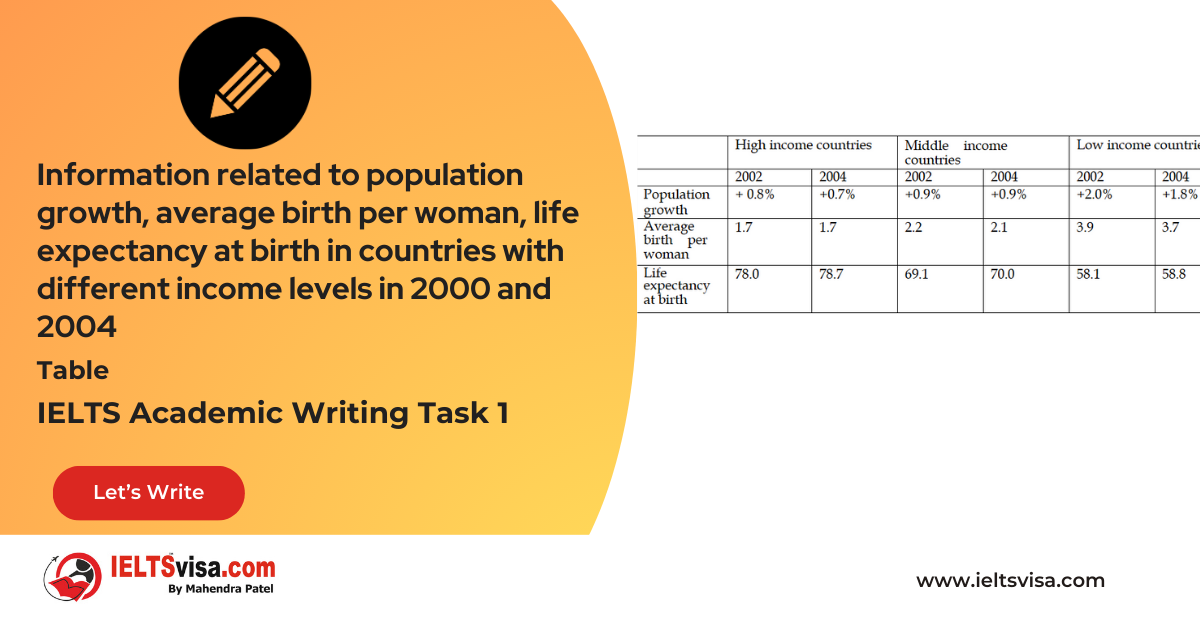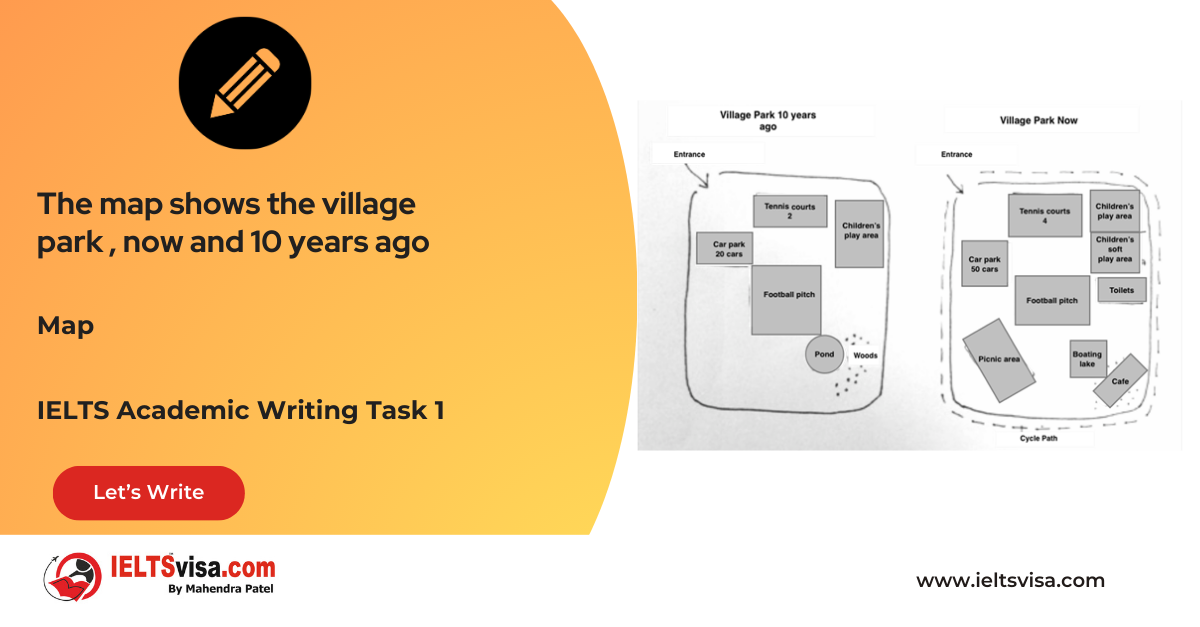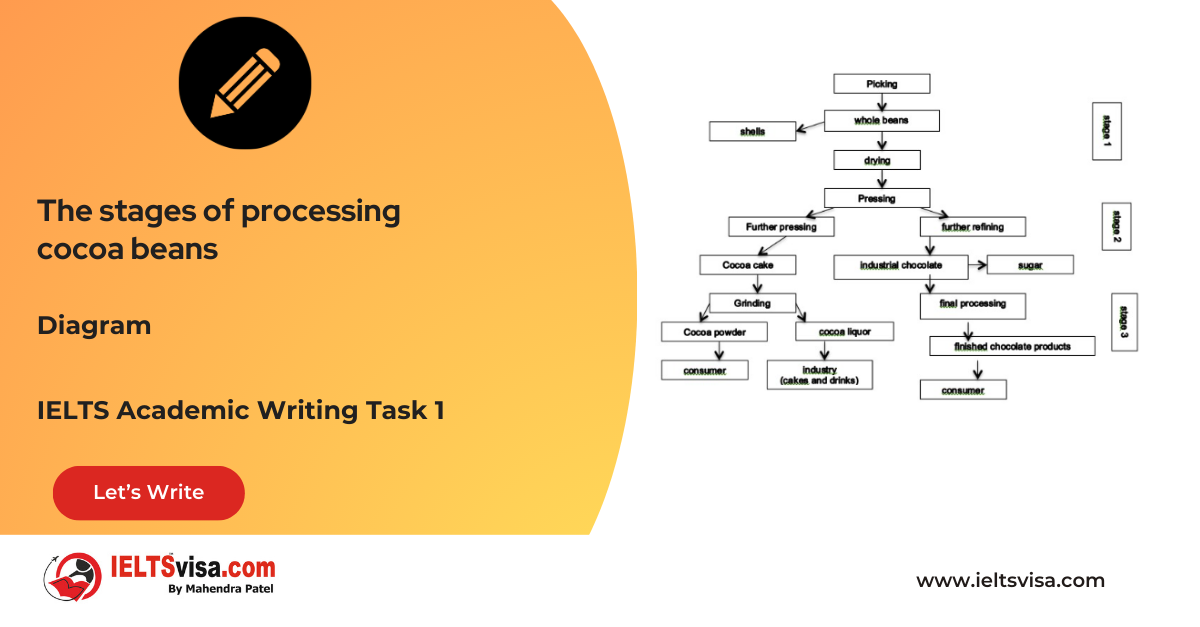Information related to population growth, average birth per woman, life expectancy at birth in countries with different income levels in 2000 and 2004
IELTS Academic Writing Task 1 - Tables

IELTS Writing Task 1 Question
The table below gives information related to population growth, average birth per woman, life expectancy at birth in countries with different income levels in 2000 and 2004. Summarise the information making comparisons where relevant.

Common Questions for the Table
1. Graph Type: Table
2. Title: Population Growth, Average Births per Woman, and Life Expectancy at Birth (2000 and 2004)
3. What are the units of measurement?: Percentage for population growth, number of births per woman, and years for life expectancy
4. Who: Countries classified by income levels (high, middle, low)
5. When: 2000 and 2004
6. Where: Global countries by income level
7. Topic: Comparison of population indicators in different income groups
Comparison Showing and Trends Any change over time (such as an increase or a decrease) is a trend.
Comparison 1 : Population Growth Trends
- Details:
1. Low-income countries had the highest population growth rate at 2.0% in 2000, declining slightly to 1.8% by 2004.
2. High and middle-income countries showed similar population growth rates that remained relatively constant over the two years.
Comparison 2 : Birth Rates and Life Expectancy
- Details:
1. Average births per woman were highest in low-income countries at 3.9 in 2000 and slightly decreased to 3.7 in 2004.
2. High-income countries maintained the lowest birth rate at 1.7 over the two years, while middle-income countries averaged just above 2.0.
3. Life expectancy at birth was highest in high-income countries, increasing from 78 years in 2000 to 78.8 years in 2004. Middle-income countries also saw an increase from 69.1 to 70 years, while low-income countries rose from 58.1 to 58.8 years.
Sample Answer
The table compares population growth, average births per woman, and life expectancy at birth across high, middle, and low-income countries for the years 2000 and 2004.
Overall, it is clear that low-income countries exhibited the highest population growth, while high-income countries had the highest life expectancy.
In 2000, low-income countries experienced a population growth rate of 2.0%, which slightly decreased to 1.8% by 2004. In contrast, both high and middle-income countries had stable growth rates, with figures remaining similar during this period.
Regarding average births per woman, low-income countries had the highest rates at 3.9 in 2000, declining to 3.7 by 2004. High-income countries recorded the lowest rate at 1.7, unchanged across both years, while middle-income countries had an average just above 2.0.
Life expectancy saw increases in all groups, with high-income countries reaching 78.8 years by 2004, middle-income countries improving to 70 years, and low-income countries rising to 58.8 years.
Top 27 Vocabulary
| Vocabulary | Type | Meaning | Synonyms | Examples |
|
Population growth |
Noun |
The increase in the number of individuals in a population |
Population increase, demographic growth |
“Low-income countries showed the highest population growth.” |
|
Average |
Noun |
A typical amount or standard |
Mean, median |
“The average birth rate in high-income countries was low.” |
|
Life expectancy |
Noun |
The average period a person is expected to live |
Longevity, lifespan |
“Life expectancy increased in all income groups.” |
|
Decline |
Verb |
To decrease or diminish |
Decrease, fall |
“Population growth in low-income countries declined slightly.” |
|
Indicator |
Noun |
A sign that shows the condition or level of something |
Measure, sign |
“Birth rates are key indicators of demographic changes.” |
|
Compare |
Verb |
To examine the similarities and differences between two or more things |
Contrast, Differentiate |
“The table compares population growth across income groups.” |
|
Exhibited |
Verb |
Displayed or showed clearly |
Demonstrated, Showed |
“Low-income countries exhibited the highest growth.” |
|
Slightly |
Adverb |
To a small degree or extent |
Marginally, Barely |
“The growth rate slightly decreased from 2.0% to 1.8%.” |
|
Stable |
Adjective |
Not changing or fluctuating, consistent |
Steady, Constant |
“Both high and middle-income countries had stable growth rates.” |
|
Rate |
Noun |
The speed or frequency of something happening |
Pace, Frequency |
“The birth rate in high-income countries was the lowest.” |
|
Recorded |
Verb |
To document or measure something |
Measured, Registered |
“High-income countries recorded the lowest birth rate.” |
|
Unchanged |
Adjective |
Remaining the same, not altered |
Consistent, Stable |
“The birth rate in high-income countries remained unchanged.” |
|
Rising |
Verb/Adjective |
Increasing in amount or degree |
Growing, Increasing |
“Life expectancy is rising in all income groups.” |
|
Group |
Noun |
A set of people or things considered together |
Category, Class |
“The groups include high, middle, and low-income countries.” |
|
Improving |
Verb/Adjective |
Becoming better or more developed |
Advancing, Progressing |
“Life expectancy improved in middle-income countries.” |
|
Period |
Noun |
A length or portion of time |
Span, Duration |
“The data compares two periods: 2000 and 2004.” |
|
Key |
Adjective |
Of central importance or significance |
Essential, Crucial |
“Birth rates are key indicators of demographic changes.” |
|
Increase |
Noun/Verb |
To become larger or greater in amount or number |
Growth, Rise |
“Population growth increased in low-income countries.” |
|
Fluctuating |
Verb/Adjective |
Changing irregularly or continuously |
Varying, Shifting |
“Some income groups had fluctuating population growth.” |
|
Proportion |
Noun |
A part, share, or number in relation to the whole |
Fraction, Share |
“The proportion of births per woman decreased in low-income countries.” |
|
Demographic |
Adjective |
Relating to the structure or characteristics of populations |
Population-based, Societal |
“Demographic changes are evident in the birth rate data.” |
|
Significant |
Adjective |
Sufficiently large or important to be worthy of attention |
Notable, Substantial |
“There was a significant increase in life expectancy.” |
|
Overall |
Adverb/Adjective |
Taking everything into account, in total |
Generally, In general |
“Overall, life expectancy increased in all income groups.” |
|
Reflect |
Verb |
To show or express something clearly |
Indicate, Demonstrate |
“The data reflects trends in population and life expectancy.” |
|
Estimate |
Noun/Verb |
An approximation of the value or number |
Approximation, Prediction |
“The population growth rates were estimated for 2004.” |
|
Declining |
Adjective |
Becoming less in quantity, quality, or intensity |
Falling, Diminishing |
“The birth rate in low-income countries is declining.” |
|
Proportionally |
Adverb |
In proportion or relation to something else |
Relatively, Comparatively |
“Proportionally, low-income countries had higher birth rates.” |

Our Books
Master IELTS Speaking Part 1
IELTS Writing Task 1 Book
IELTS Writing Task 2 Book
Writing Task 1 Question Types
Practice IELTS Other Modules
IELTS Listening
The IELTS Listening test assesses how well you can understand spoken English in various contexts. It lasts about 30 minutes and is divided into four sections with a total of 40 questions. The listening tasks become increasingly difficult as the test progresses.
IELTS Academic Reading
The IELTS Academic Reading section assesses your ability to understand and interpret a variety of texts in academic settings. It is designed to evaluate a range of reading skills, including skimming for gist, reading for main ideas, reading for detail, understanding inferences, and recognizing a writer's opinions and arguments.
IELTS Speaking
The IELTS Speaking test assesses your ability to communicate in English on everyday topics. It lasts 11-14 minutes and consists of three parts: introduction, cue card, and a discussion based on the cue card topic.
IELTS General Reading
IELTS General Reading tests your ability to understand and interpret various types of texts. Here are some key areas and types of content you can expect to encounter in the reading section, along with tips for effective preparation.
IELTS Academic Writing Task 1
In IELTS Academic Writing Task 1, you are presented with a visual representation of information, such as graphs, charts, tables, or diagrams, and you are required to summarize, compare, or explain the data in your own words.
IELTS General Writing Task 1
In IELTS General Writing Task 1, you are required to write a letter based on a given situation. The letter can be formal, semi-formal, or informal, depending on the prompt. Here’s a breakdown of the key components to include in your letter
IELTS Academic Writing Task 2
In IELTS Academic Writing Task 2, you are required to write an essay in response to a question or topic. Here’s a guide to help you understand the essential elements of this task
IELTS Exam Tips
To succeed in the IELTS exam, practice regularly, familiarize yourself with the test format, improve your vocabulary, develop time management skills, and take mock tests to build confidence.
Grammer for IELTS
Grammar is the foundation of effective communication in English. Understanding tense usage, subject-verb agreement, and sentence structure enhances clarity and coherence in writing and speaking.
Vocabulary for IELTS
Vocabulary plays a crucial role in the IELTS (International English Language Testing System) exam, especially in the Speaking and Writing sections. Here’s an overview of why vocabulary is important and how it impacts your performance
RECENT IELTS SAMPLES QUESTIONS AND ANSWERS
Task 1 – Map -Changes in Pentland Coastal Area from 1950 to 2007
[df_adh_heading title_infix="IELTS Writing Task 1 Question" use_divider="on"...
Task 1 – Map -Changes in a Park from 1980 to Present
[df_adh_heading title_infix="IELTS Writing Task 1 Question" use_divider="on"...
Task 1 – Maps – The changes made in an Australian park
20:00 Start Pause Stop [df_adh_heading title_infix="IELTS Writing Task 1 Question" use_divider="on"...
Task 1 – Maps- The map shows the village park, now and 10 years ago
20:00 Start Pause Stop [df_adh_heading title_infix="IELTS Writing Task 1 Question" use_divider="on"...
Task 1 – Map -Changes in Sydney International Airport from 1930 to Present
[df_adh_heading title_infix="IELTS Writing Task 1 Question" use_divider="on"...
Task 1 – Diagram – The stages of processing cocoa beans
20:00 Start Pause Stop [df_adh_heading title_infix="IELTS Writing Task 1 Question" use_divider="on"...













